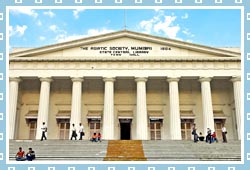 |
History
Mumbai's Town Hall is a colonial structure and was built in 1833. The plan for its construction began in 1811. After raising an amount of Rs.10,000 through a lottery, by the 'Literary Society of Bombay' (Mumbai), the funds were used for building the museum and library. These funds were not enough for the entire construction, therefore the society had to approach the government for more funds. 10 years later, the construction of the Town Hall was finally complete.
Architecture
Sir John Malcolm, the then Governor of Bombay (Mumbai) praised the palatial structure and according to him - "it is the most magnificent structure that taste and munificence combined have as yet erected in India". The Town Hall was designed by Colonel Thomas Cowper who was one of the best engineers in Bombay (Mumbai). With a span of 200 feet and height of 100 feet, the structure was inspired by Greek and Roman styles of architecture. The entrance of the building is adorned with a Grecian portico and 8 impressive Doric styled pillars. There is a flight of 30 steps leading to the entrance of the Town Hall. The entire construction was made of stones brought from England and was beautifully designed in a neo-classical fashion. Within the building, the floors are covered in ancient wood, the staircases are spiral and the terraces are adorned with beautiful wrought iron. The hall boasts of a collection of remarkable marble statues of Indian patrons of the 19th century.
Significance Of Town Hall
The Town hall houses a library and a museum. Apart from the ancient manuscripts in Persian, Prakrit, Urdu and Sanskrit, several other treasures are safely preserved inside the hall. A collection of 1,000 ancient coins and the exceptional gold 'mohur' that once belonged to Akbar, the greatest Mughal Emperor, are just a few of the priceless treasures found here. Dante's first issue of 'Inferno' is one of the most precious treasures at the Town Hall.
Overlooking the Horniman Circle Gardens and built in 1883, the Town Hall is one of Mumbai's prized architectural buildings. The Town Hall houses a collection of ancient manuscripts and the rarest treasures of India. A place worth visiting in Mumbai, the Town Hall is a tourist hot-spot.